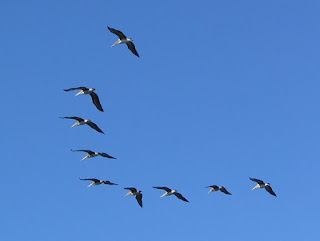Bird, Airplane, and Bicycle Formations
Yes, I know this is an unusual title as well as combination of subjects. Stay with me. In "Engineering and Migratory Birds", it was shown that birds are designed and equipped for their long journeys. Now we will look at the dynamics of that V formation.
"Because it is cheep, Cowboy Bob?"
That's cute. Actually, the formation is cheaper than going it alone when it comes to the expenditure of energy. There is also physics involved that they do not have to consider — but researchers do.
 |
| Pelicans in formation (cropped), Flickr / Peter Kaminski (CC BY 2.0) |
When airplanes are flying in a tight formation, not only do they have to keep from touching each other and possibly losing control, but the movement of the air affects them. (I wonder if this is an example of aerodynamic biomimetics, where humans draw inspiration from what they observe in nature?) Obviously, birds are using their own power and not jet engines or propellers.
In a surprisingly similar way, bicycles in a pace line have the rider at the front taking the brunt of the wind, and riders further back and taking less. This is called drafting. (Sometimes people try to get that benefit by riding dangerously close to a big rig on the highway. Also, this scene from Breaking Away really is possible.) These things all come into play when birds fly in formation — and their muscle-powered flapping makes the dynamics even more profound.
Why do so many birds fly in a V formation? Is it a matter of safety in numbers, an energy saving maneuver, or just a good way to keep a more navigationally astute leader in sight? The aeronautical adjustments required to maximize the energetic advantages of the V formation are remarkably complex. A study of northern bald ibises just published in Nature shows, however, that birdbrains can keep up and perhaps teach a few aerodynamic lessons themselves.
To read the rest of this interesting article, navigate over to "Why Do So Many Birds Fly in a V Formation?"